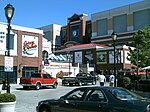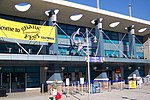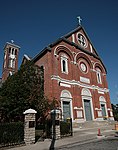Daniel Carter Beard Bridge

The Daniel Carter Beard Bridge (also known colloquially as the Big Mac Bridge and more recently as the ' ' ' Butter Bridge' ' '), is a yellow twin span steel bowstring arch bridge crossing the Ohio River in Cincinnati, Ohio. It carries Interstate 471 between Cincinnati, Ohio, and Newport, Kentucky. As to the origin of this nickname, its yellow arches are said to be similar to the "Golden Arches" logo of McDonald's restaurant. The nickname was coined by local residents after the bridge's golden arches were constructed. As for the new name, it is the same color as butter; the spreadable food made from milk. The arches are golden colored which 'Butter' was referred to instead of the word 'Gold'. In the 1980s, McDonald's considered opening a floating restaurant at the base after the nickname caught on, but never went to construction. This bridge has a main span of 750 feet (230 m) and has a total span of 2,100 feet (640 m). It is named in honor of Daniel Carter Beard, the founder of the Sons of Daniel Boone and one of the founders of the Boy Scouts of America.The bridge was originally designed by Hazelet + Erdal, now URS Corporation. The bridge was originally configured with three lanes and an emergency shoulder on each span. In December 2000, with the completion of a reconstruction project on the 3rd Street Viaduct approach, the bridge was reconfigured to four lanes on each span.
Excerpt from the Wikipedia article Daniel Carter Beard Bridge (License: CC BY-SA 3.0, Authors, Images).Daniel Carter Beard Bridge
Dave Cowens Drive,
Geographical coordinates (GPS) Address External links Nearby Places Show on map
Geographical coordinates (GPS)
| Latitude | Longitude |
|---|---|
| N 39.1006 ° | E -84.4945 ° |
Address
Daniel Carter Beard Bridge
Dave Cowens Drive
41071
Kentucky, United States
Open on Google Maps










